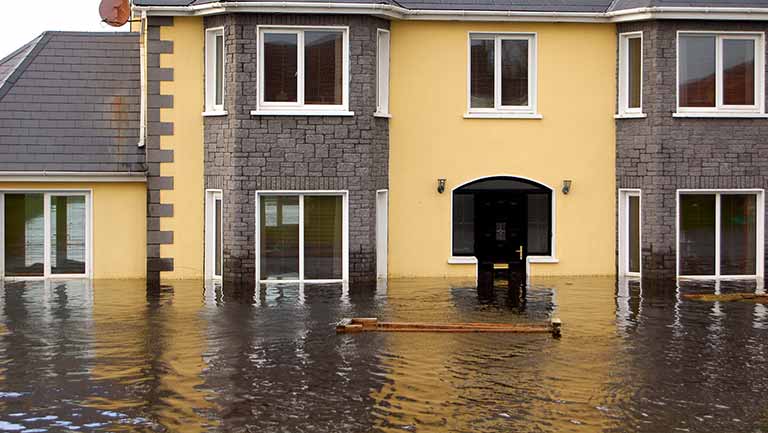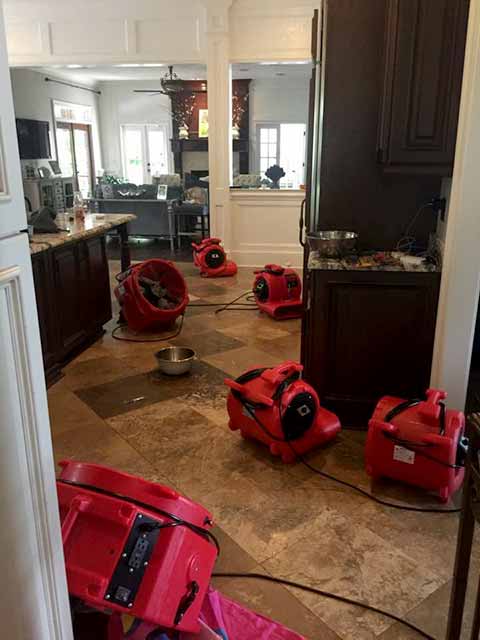Water Damage Restoration – The Process of Cleaning Flood Damage
Water Damage Restoration – The misfortunes flood damage can bring a family can be devastating.
It’s crushingly hard to watch on as your home gets ripped apart right in front of you.
More so, the mess it can create is nothing like anyone can ever imagine.
Having worked closely with families, we’ve seen the impact of loss flood can cause and understand the nature of the struggle you face.
Not to mention recovering after a flood can be such a long, drawn-out process that sucks your energy away.
It’s difficult to find the strength to clear out your home when you’ve lost so much.
Together with the pain of clearing out your home, one of the most heartbreaking aspects of flooding is having to put the pieces back together.
It takes a considerable amount of time for you to put the things you had taken apart back together, which can be overwhelming.
So it is important that you enlist the help of a professional for your restoration efforts.
What You Should Do After a Flood Damage
If there has been flooding in your home or business premises, you may want to hire a professional to help you clean up.
Enlisting the help and support of restoration professionals enables you to deal mold or flood damage effectively.
It is also advisable to call in a professional if you have asthma, open wound, allergies or other breathing problems.
Such conditions make you sensitive to mold and flood water. Besides, flood water generally contains bacteria, sewage, mud, and chemical toxins.
Getting a professional to clean out your flooded home helps you to protect yourself from these contaminants.
Professional cleaners have the experience needed for effectively supporting you in your endeavors to salvage your property.
They can assist you in any restoration work and have the technologies to help you claim back your property quickly.
The Flood Damage Cleaning Process
It matters little whether the flood is caused by excessive rainfall, poor water management, dam burst, or breaching of banks.
We recommend that you call in restoration professionals as soon as floodwaters recede to mitigate damage. The longer you allow water to sit, the greater the flood damage you are likely to have.
Professionals who provide flood damage restoration will take the following steps to restore your home back to its original condition:
1. Assess the level of damage: After you call in a pro, they swing into action. Restoration companies carefully assess the level of damage to see what needs to be done.
2. Remove standing water and moisture: After the evaluation, carpet cleaners use truck mounted water extraction equipment and dehumidifiers to extract water from affected materials. Cleaners who provide flood damage restoration services also take care of any damage caused by excess water. Immediate removal of excess water allows for proper cleanup to commence before more harm is done.
3. Remove furniture: Professional restoration companies will remove furniture and other personal effects from the house. Items such as solid wood furniture and taken out, while drawers and doors are also removed for cleaning.
4. Carpet Restoration: Flood can cause severe damage to carpets, as they absorb water so easily. Prolonged exposure to water can rot the underlying fibers of the rug and increase the risk of mold growth. To avoid this, carpet cleaners remove the carpeting and padding to assess damage and save as much of your rug as possible.
The removal process requires experience. So it will help if you call in the professionals to assist instead of doing it yourself since you lack the expertise and tools necessary to save your flooring or carpeting from the damaging effects of water.
5. Sheetrock and Baseboards: Water damage from flooding can cost you your sheetrock and baseboards.
When flooding occurs, the water will get absorbed into the sheetrock and baseboards, causing them to swell or buckle.
This, in turn, affects your wall framing and insulation.
Floor care professionals use a moisture meter to identify wet walls and finishes.
The tool makes it easier to determine what materials to keep or discard of.
The moisture meter also enables the professionals to identify when walls are dry enough for re-insulation and closing up.
6. Cleaning and Disinfection: Floodwater often contains infectious organisms that can affect your health.
So there’s a need to clean and disinfect household items once wet and contaminated materials have been removed.
Moreover, the presence of waters and residue can cause mold growth.
Restoration professionals use an alkali solution such as washing soda or tri-sodium phosphate to clean and sanitize the area and materials affected by the flood.
They also use a mixture of borax and water for cleaning.
After the cleaning, they rinse all surfaces with a disinfectant such as a mixture of chlorine bleach and water.
7. Drying Process: Once water and debris have been removed and the house is cleaned, drying out the area is the next step.
Drying and circulating air is crucial in dealing with flood damage, as it helps to prevent the onset of mold growth.
This effort is completed by using an anti-bacterial/antifungal spray to prevent issues that may arise from your flood damage restoration attempts.
Restoration professionals place air movers and dehumidifiers around the affected area to speed up drying time.
They also use air scrubbers to draw the contaminated air from the area while also supplying fresh air that is free of chemicals.
Combining commercial strength fans and dehumidifiers help ensure faster drying times, due to greater airflow.
This is because a stronger air flow ensures better water absorption, which in turn, lowers damage and makes it less likely that you will suffer long-term effects of water damage.
Combining regular home fans and dehumidifiers will not create a strong enough airflow or pull enough moisture from the air to ensure proper damage mitigation.
Failure to provide adequate air circulation can have negative impacts such as mold and mildew damage in carpeting.
It may also affect your upholstery, walls, and even cause warping in wood and drywall.
Drying time
It may take anywhere from twelve hours to a few weeks to completely dry out your flooded home.
The total drying time depends on factors such as the type of materials used to build the house, severity of flooding, and the amount of air in circulation.
For instance, dehumidifiers achieve faster drying times than say air drying or forced air/fans.
The total drying time will also be affected by the moisture content of the air.
8. Mold remediation services: Often, basement flooding leads to mold growth.
As a result, restoration professionals check for signs of mold and provide mold remediation services if there’s existing mold.
The remediation process cures and prevents new growth by addressing the moisture source.
9. Water Damage Restoration: Once they establish that their clean-up efforts have been successful, restoration companies will work with your insurer to develop a reconstruction plan.
The plan is geared toward restoring your basement to its original, pre-flood condition.
Dealing with Flood Damage Costs
Dealing with flood damage costs isn’t fun.
However, it is something that you have to face if your home is underwater.
It’s necessary to form a plan to deal with the financial costs of tackling flood damage before you call in the professionals.
Your first step should be to call your insurance company to see if you can have them evaluate the situation.
Policies often cover water damage, including the costs of water removal, flooring, as well as hiring a professional restoration company.
You can also hire a professional out-of-pocket.
In this case, you’ll need to take photos or video to record the damage – it could help with your insurance claim.
Also, keep any receipts for work done so you can claim for the cost of repairs.
If your papers are flooded or you can’t find your policy document, you can check with your insurer.
They should be able to see you on their database.
Final Words
Recovering from flood damage is possible. However, it is essential to bear in mind that this depends much on your ability to take prompt action. The effects of flood damage to your home or office can progress very quickly if you don’t act.
It only takes a few hours for bacteria to grow and an unpleasant musty odor to spread throughout your space. The damage can also cause your furniture, sheetrock, and baseboards to swell and disintegrate within a very short time.
Over time, damage can go from bad to worse, resulting in costly repairs. To prevent further destruction and reduce restoration cost, you’ll have to start the mitigation process as quickly as possible.
If you’re looking to obtain professional restoration assistance, you can rely on our expertise for the most thorough cleaning. We use advanced technology, tools, and products to extract water and moisture from your home and promote effective drying time.
We prepare, plan, and help you deal with flood damage, ceiling water damage, water extraction, basement repair, and other water-related issues.







Leave A Comment